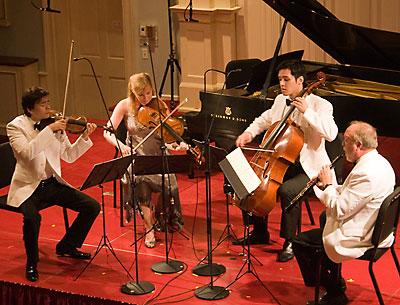Opinion: An Elegant Entertainment

The fourth concert of the Bridgehampton Chamber Music Festival, held last Thursday at the Bridgehampton Presbyterian Church and called “Winds of Change,” featured winds, strings, and piano. It included a lesser-known sextet and a sharp-witted musical collage, which were bookended by two of the more standard chamber music fare.
First was Mozart’s Quartet for Oboe, Violin, Viola, and Cello in F. As the first movement began, I wondered how such excitement could at the same time be so delicate. This poised and restrained spirit continued in the sustained Adagio and in the understated playfulness of the Rondeau. But such is the essence of Mozart, and with the oboe played by John Snow and the strings played by Stefan Jackiw, Cynthia Phelps, and Michael Nicholas, the reading of this quartet was a model of Mozartian elegance.
We were told that the high F in the oboe part was unusual in the 18th century and is even unusual today. It was played with masterful control and tone by Mr. Snow, and such was the standard for the whole quartet.
The cleverly named “Moz-Art” by the 20th-century composer Alfred Schnittke was an amusing bit of satirical humor. It is a duet for violins and was played by Mr. Jackiw and Jonathan Crow, who is marking his first season at the festival. It is based on a pantomime by Mozart of which only fragments survive, along with snippets of other Mozart melodies that are more familiar.
According to Schnittke, “the polytonal effects sound quite artificial and comical because of their quasi-falseness. Overall one is reminded of a country festival at which music of various types is heard simultaneously. . . . To be quite honest, this is above all a musical joke.”
Not only was it entertainment of the highest order, but we were in for two other surprises. A minute or so into “Moz-Art,” Mr. Jackiw began to whistle as though he were playing a third instrument, and then, not to be outdone, Mr. Crow, in the midst of playing, un-tuned and retuned a string on his violin, making a jaw-droppingly humorous effect — a treacherous feat that was well executed. At the end, they had to take a second bow.
Ludwig Thuille was a 19th-century German musician who was quite popular in his day but today is known almost exclusively for his Sextet for Winds and Piano, which was next on the program. The five wind instruments made a colorful contrast to one another, and an overall contrast to the strings of the first piece, with Marya Martin, the artistic director of the festival, on flute, John Snow on oboe, Sarah Beaty, who is appearing at the festival this year for the first time, on clarinet, Peter Kolkay on bassoon, Stewart Rose on horn, and Orion Weiss on piano.
Ms. Beatty had a rather engaging presence, moving so much with the music that she nearly stood up on a number of high points.
Ms. Martin had said in her opening comments that Thuille sounds something like Brahms, and that is true. Thuille studied with Josef Rheinberger, and especially in the second movement, Larghetto, I could also hear a resemblance to his organ concertos in some of the sounds that evoke a broad Alpine landscape and its horn calls.
The third movement, the Gavotte, brought to mind a charming, rustic peasant dance, with each instrument colorfully taking a turn, as though changing partners.
In 1842 Robert Schumann devoted a year to writing in a genre that he had hardly composed for before: chamber music. During this time, he wrote the Piano Quintet in E flat, with the fairly novel combination of piano with four strings. Both Schumann’s wife, Clara, and Franz Liszt criticized the piece, but it has since become a staple. Mr. Crow, Mr. Jackiw, Ms. Phelps, and Mr. Nicolas were the four string players, with Mr. Weiss again on piano.
Although it is hard to pick out one movement, I thought the second movement, “In modo d’una marcia,” was especially poignant. The main theme is dark and somber, with muted tones and angular rhythms where the small spaces of silence are as important as the notes themselves.
There is a place where, after the second contrasting episode with its restless triplets, the viola makes a surprising restatement of the first march theme. It is one of those breathtaking passages in chamber music literature — and one could see the expressions on the faces of the players, completely caught up in the transcendent beauty of the moment.
The chamber music festival has developed a loyal following, and deservedly so. It is no surprise that the nearly full house was more than enthusiastic about the whole evening.
There are five more concerts left in the festival, which continues until Aug. 19. In my book, missing one of them would be missing one of the finest features of an East End summer. I would like to highlight two of the coming events. The Saturday Soirée on Aug. 18, which is promised to last from 6:30 p.m. to no later than 7:30, allowing time for dinner or other plans, will offer a premiere of a flute and piano sonata by Paul Brantley, commissioned by Ms. Martin, and Piazzolla’s “Le Grand Tango.”
Also, the festive finale on Aug. 19 includes a quintet by Luigi Boccherini that is truly rarely heard. According to Derek Delaney, the executive director of the festival, it was recorded about 20 years ago, but the festival staff couldn’t readily find the score. After searching for it for some time, it was finally found in Madrid — a handwritten manuscript, that is — and it was put into a more readable format with a computer notation program for the players. It promises to be a revelation.
More information is at bcmf.org or 537-6368.
